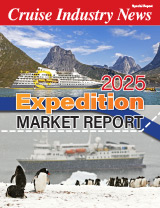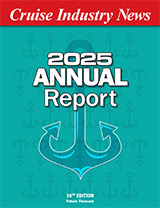At a mild state of the industry conference at the Miami Cruise Convention this week, industry leaders sounded off on a variety of topics, including much time allotted on the recent, and now over, economic recession, new and looming environmental rules, consumer behavior, emerging markets and more.
CLIA: Four Factors Driving Industry Success
Jan Swartz, marketing chair for the Cruise Lines International Association and EVP, marketing and sales for Princess Cruises and Cunard Line talked about the challenging current economy and unemployment rate.
But, the industry is still moving forward, according to Swartz. “The cruise industry continues to grow, with 15 million guests carried among CLIA lines in 2010, continuing 20 years of growth.” CLIA estimates 16 million passengers for 2011, among member lines.
Worldwide, the 2011 Cruise Industry News Annual Report estimates just over 19 million passengers.
She called it a “remarkable accomplishment,” pointing out the orderbook that has “begun again.”
Click here to see the current cruise-ship orderbook through 2015.
“How is it in the context of a such troubled global economy we can report these statistics?” questioned Swartz. “We say it’s no field of dreams, we don’t hear ‘If you build it they will come,’ – it takes hard work, we had to drop our prices to uncomfortable levels, creating more value for the consumer”
There were four factors for success, said Swartz: market penetration, value, innovation and global teamwork.
She conclude that the cruise industry can “whether the storm.”
Kruse: “Untapped Potential is Huge”
Stein Kruse, president and CEO of Holland America Line, credited the new Alaskan Governor for the changes the state pushed through. “You are seeing our response, bringing passengers back in 2012,” said Kruse. “It shows the partnership that can exist between private industry and government can really work.”
Kruse said he was increasingly positive and bullish on the industry’s future.
“When penetration levels are as low as they are, in the U.S. less than 20 percent of the population has ever cruise, there is a tremendous untapped potential,” explained Kruse, noting Europe and Australia’s low market penetration as well. “The untapped potential is really tremendous.”
“We must not forget the baby boomer generation. There are 76 million people between 47 and 65 years old in the U.S. right now. Their purchasing power is incredibly strong.
“After living expenses, vacations are the first thing they are looking for,” continued Kruse.
However, there are “fragmented regulations,” said Kruse., “Our officers have a full-time job trying to understand what regulation they are (between ports). The ECAs will have profound consequences for ports. The EPA decision to enforce 200-miles simplifies enforcement but completely disregards the economy impact to that decision.”
And fuel costs are creeping towards a 2008 level. “I do not personally believe that fuel prices at these levels are sustainable,” Kruse added. “I believe prices will come down as fast as they went up once calm is restored in the markets.”
Carnival: Profitable During Downturn
“The recession was more sustained and more damaging than anything since 1929,” explained Gerry Cahill, president and CEO of Carnival Cruise Lines.
“We filled our ships, lowered prices and were still profitable,” said Cahill. “Lower prices enabled us to increase new people to cruising.”
Cahill said that by suspending dividends, Carnival saved $1.3 billion in cash annually. That allowed Carnival Corporation to fund the delivery of new ships and pay for product improvements, according to Cahill.
Carnival Corp. has posted a profit every year since going public in 1987.
“It may seem intuitive to cut back on the product in a recession but it may not be a good idea,” Cahill explained, meaning consumers had the same expectation, or had a heightened expectation, regardless of the lower ticket prices.
Consumers became very focused on value, Cahill said. “That emphasis on value will continue in the future. We need to do a better job defining the product and showing the consumers the value.”
Cahill said the drive-to homeports helped during the recession, cutting the cost of airfare of out ticket prices.
“Our pricing is totally driven by supply and demand… and we need all the demand from any channels we can get,” noted Cahill, pointing out both direct bookings and working with travel agents.
Growth Track
Kevin Sheehan, CEO of Norwegian Cruise Line, said that ship launches benefit the entire industry due to the increased media attention and that he “wasn’t getting caught up in the supply and demand.”
“We as an industry have a huge wild west opportunity to build this brand,” said Sheehan.
Adam Goldstein, president and CEO of Royal Caribbean International, said Royal Caribbean plans to continue growing, but at a more moderate place.
“We have emerged from the recession much more global before the recession,” said Goldstein. Royal Caribbean will send almost half its fleet to Europe this summer.
Pierfrancesco Vago, CEO of MSC Cruises, added: “Europe has not been penetrated. So we still have a lot of ground to cover, there is a lot of marketing happening. The old perception is that cruising is boring and expensive. Cruising will always be a tremendous value for money.
“Europe today may be the new Caribbean,” Vago said.
Dan Hanrahan, president and CEO of Celebrity Cruises talked about unifying the brand by “Solsticizing” the Millennium-class ships.
Hanrahan said that the supply is slowing down, and it’s not the “8 to 12 percent capacity increase yearly it was a couple years ago. You will see a stronger cruise industry come out of this. As a result of the supply growth we have seen, we have been able to open up new markets.”
Celebrity will send the Solstice to Australia for winter 2012/2013, in a market and region that is quickly starting to heat up. Carnival Cruise Lines will also have a ship year-round in Australia starting in late 2012, the first time the brand has ever had a ship based in a market outside North America year-round.
Vago: Outlook from the Old World
With a growing cruise market, more vacation time and low market penetration, Vago said the potential in Europe was huge. “The old world is becoming the new world of cruising.”
However, economic issues loom over Spain, Portugal and Italy, which could put a stop on the European growth curve.
Eastern Europe is growing too, said Vago, with 650,000 passengers being sourced in the region.
“Cruising in the Med and Baltic is becoming the new traditional way of touring Europe,” Vago stated. “You pack once and have the secure cocoon of the ship.”
Regulatory Environment
“The air emissions,” said Goldstein, “are at the forefront of the industry.” The ECA will “change our world,” he added.
“It’s all in our interest to reduce gastro-intestinal illness,” Goldstein continued. “That is one of our biggest sources of negative attention.”
He called the recent Vessel Safety and Security Act a “win-win,” and added that he hoped that would become the standard worldwide.
The Maritime Labor Convention (MLC), which passed in 2006, has only been ratified by 10 countries. Twenty more will need to sign off for the MLC to come into play.



